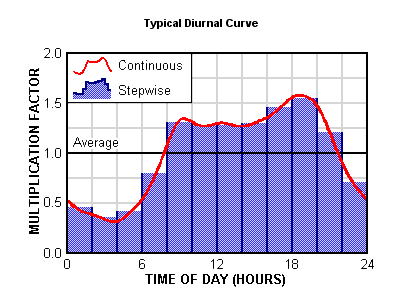Working with Patterns
A dynamic analysis is actually a series of Steady State analyses run against time-variable loads such as sewer inflows, demands, or chemical constituents. Patterns allow you to apply automatic time-variable changes within the system. The most common application of patterns is for residential or industrial loads. Diurnal curves are patterns that relate to the changes in loads over the course of the day, reflecting times when people are using more or less water than average. Most patterns are based on a multiplication factor versus time relationship, whereby a multiplication factor of one represents the base value (which is often the average value).
Using a representative diurnal curve for a residence as illustrated below, we see that there is a peak in the diurnal curve in the morning as people take showers and prepare breakfast, another slight peak around noon, and a third peak in the evening as people arrive home from work and prepare dinner. Throughout the night, the pattern reflects the relative inactivity of the system, with very low flows compared to the average.
There are two basic forms for representing a pattern: stepwise and continuous. A stepwise pattern is one that assumes a constant level of usage over a period of time, and then jumps instantaneously to another level where it remains steady until the next jump. A continuous pattern is one for which several points in the pattern are known and sections in between are transitional, resulting in a smoother pattern. For the continuous pattern in the figure above, the multiplication factor and slope at the start time and end times are the same. This is a continuity that is recommended for patterns that repeat.
Because of the finite time steps used for calculations, this software converts continuous patterns into stepwise patterns for use by the algorithms. In other words for a time step a multiplier is interpolated from the pattern curve. That multiplier is then used for the duration of the time step, until a new multiplier is selected for the next time step.
Patterns provide a convenient way to define the time variable aspects of system loads.
Click one of the following links to learn more about working with patterns:

